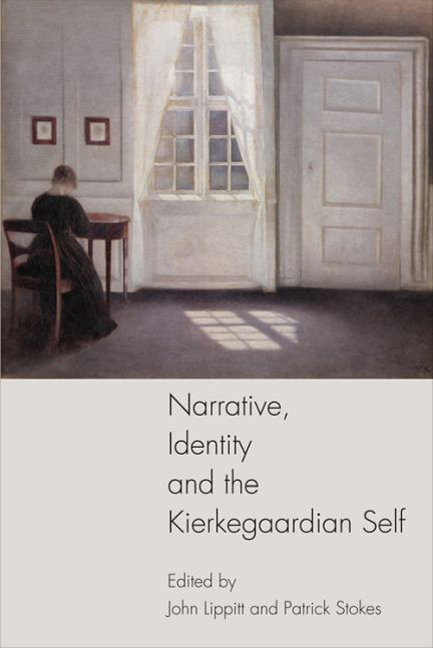Book contents
- Frontmatter
- Contents
- Acknowledgements
- Abbreviations
- Contributors
- Introduction
- 1 The Moments of a Life: On Some Similarities between Life and Literature
- 2 Teleology, Narrative and Death
- 3 Kierkegaard's Platonic Teleology
- 4 Narrative Holism and the Moment
- 5 Kierkegaard's Erotic Reduction and the Problem of Founding the Self
- 6 Narrativity and Normativity
- 7 The End in the Beginning: Eschatology in Kierkegaard's Literary Criticism
- 8 Forgiveness and the Rat Man: Kierkegaard, ‘Narrative Unity’ and ‘Wholeheartedness’ Revisited
- 9 The Virtues of Ambivalence: Wholeheartedness as Existential Telos and the Unwillable Completion of Narravives
- 10 Non-Narrative Protestant Goods: Protestant Ethics and Kierkegaardian Selfhood
- 11 Narrativity, Aspect and Selfhood
- 12 The Senses of an Ending
- 13 The End? Kierkegaard's Death and its Implications for Telling his Story
- Bibliography
- Index
11 - Narrativity, Aspect and Selfhood
Published online by Cambridge University Press: 15 September 2017
- Frontmatter
- Contents
- Acknowledgements
- Abbreviations
- Contributors
- Introduction
- 1 The Moments of a Life: On Some Similarities between Life and Literature
- 2 Teleology, Narrative and Death
- 3 Kierkegaard's Platonic Teleology
- 4 Narrative Holism and the Moment
- 5 Kierkegaard's Erotic Reduction and the Problem of Founding the Self
- 6 Narrativity and Normativity
- 7 The End in the Beginning: Eschatology in Kierkegaard's Literary Criticism
- 8 Forgiveness and the Rat Man: Kierkegaard, ‘Narrative Unity’ and ‘Wholeheartedness’ Revisited
- 9 The Virtues of Ambivalence: Wholeheartedness as Existential Telos and the Unwillable Completion of Narravives
- 10 Non-Narrative Protestant Goods: Protestant Ethics and Kierkegaardian Selfhood
- 11 Narrativity, Aspect and Selfhood
- 12 The Senses of an Ending
- 13 The End? Kierkegaard's Death and its Implications for Telling his Story
- Bibliography
- Index
Summary
I
Contemporary discussions about narrativity and selfhood commonly make reference to Alastair MacIntyre's After Virtue and to the work of Charles Taylor from the seventies and eighties, especially Sources of the Self. Paul Ricoeur's writings on the subject also figure prominently, and more recently, Marya Schechtman's The Constitution of Selves has powerfully shaped the terms of the debate. Each of these philosophers defends a narrative model of personal identity as an alternative to physicalist or embodied theories, on the one hand, and psychological theories on the other. These latter approaches have tried to understand selfhood either by appeal to a self-identical subject (be it the body, brain, or soul) persisting through change and time, or by appeal to some appropriate sort of causal sequencing. On either model, selfhood is something given at a time, whereas the narrativists – as I'll call them – claim that selfhood is the sort of thing that can only occur over time. Being a self requires having a life and it's impossible to have a life all at once. Taylor, echoing Martin Heidegger, refers to the ‘inescapable temporal structure of being in the world: that from a sense of what we have become […] we project our future being’ (Taylor 1989: 47). Schechtman draws on Christine Korsgaard's idea that just as being a self at any given time is a unity of many parts – desires, values, interests, goals – it is equally a unity of such parts over time (Korsgaard 1996). My past and future are parts of me. Narrativists claim that the best model we have for understanding how a self holds itself together in this way over time is found in narratives.
In this paper I connect this narrativist thesis to the role that death plays in Heidegger's account of selfhood in Being and Time (Heidegger 2001). My claim is that to be a self is to be an event with the kind of temporal structure expressed in narratives. Furthermore, since we humans do not just happen to be selves but take ourselves to be selves, selfhood entails taking oneself up in terms of this temporal structure.
- Type
- Chapter
- Information
- Narrative, Identity and the Kierkegaardian Self , pp. 169 - 185Publisher: Edinburgh University PressPrint publication year: 2015

